McGill President and Vice-Chancellor Deep Saini’s recent messaging surrounding the on-campus pro-Palestine protests against investments and ties to Israel have repeatedly characterized those involved as violent and vandalizing, leaving little mention of the intent behind their actions. His language does not merely criticize the breaking of windows—to me, it paints the protestors as threats to order itself, erasing the political urgency that led to their demonstration.
This fear-mongering language—referencing mob rule, cacophony, and terror—functions to spread antagonism towards the protestors’ destruction of property, both on the night of Feb. 5, when protestors smashed the windows of various McGill buildings, and prior. Saini’s brief mention of the university’s resolute stance on Boycott, Divest, and Sanction (BDS) regarding the State of Israel hints that the property damage stood for more than vandalism; however, his critical language suggests the contrary.
These evident biases in the frequent messages to the McGill community beg the question of the president’s obligations. On the one hand, he speaks on behalf of the administration, representing those at whom the damages were directed. However, he is also addressing the McGill community directly, and therefore owes his audience a comprehensive and nonpartisan truth that avoids the demonizing language he employs. In the latter regard, Saini’s rhetoric strays far from the mark.
Given the growing antagonism between the administration and the protestor body, Saini’s rhetoric only fosters further division, rather than bridging the divide. His duty, rather than offering his own vision of the protestors, should be to service the broader McGill community with information and resources such that individuals may draw their own conclusions. His position as President of McGill means that his language does not merely inform the McGill community—it actively influences their perception. When such communication is dismissive of the central motivation behind the political activism it condemns, Saini’s audience must contend with the blurred lines between fact and presidential opinion. Saini thus fails his presidential duty to the McGill community, which notably demands a leadership role in promoting McGill’s broad well-being. In assuming such a role, he obligates himself to each constituency of the university—the administration, the faculty, and the student body—in equal part. As such, his commitment to community well-being calls for constituents who are, if not in agreement, then in decorum; Saini’s harsh rhetoric definitively harms this presidential ideal.
This is not to say that Saini ought to promote the protestors’ actions as noble or well-meaning. On the contrary, doing so would fail his imperative in equal measure to his reductive condemnations. Rather, the notices Saini issues to the McGill community are obliged to fact and incontrovertible truth—or as close to this as such a memo can manage. That is, it is his imperative to present the community not with an argument, but the firm basis on which his audience may construct one, be it for or against those in question. The president’s current language, describing the Feb. 5 protestors as violent vandals, disrupting peace and education, serves no purpose but to curate the information reaching his audience, and thus influence student-held views; or perhaps it only serves to alienate the student body. His rhetoric reminds me of what I saw in the mainstream media, demonizing pro-Palestinian protestors rather than truly listening to their demands, engaging with their arguments, and walking a moderate line between the parties in dispute.
This being said, it is crucial that students turn their attention to the motives behind Saini’s presentation of student protest. As it stands, Saini presents the McGill community with a highly curated and reductive view of events focused on the physical destruction of property while ignoring the pressing message behind the protests. This stands firmly against the McGill community’s right to unambiguous, axiomatic truth on which to form its own decisive opinion. As such, his imagery and language deserve at once criticism and skepticism. Indeed, Saini’s communications—while riddled with notions of antagonism and presumption in line with the administration’s ongoing use of disparaging language surrounding the BDS goals—are not to be completely neglected. However, they cannot be taken as a source, nor even a cross-section, of truth. Rather, Deep Saini’s words are best regarded as they are: Another divisive, albeit reputed, man’s opinion.







